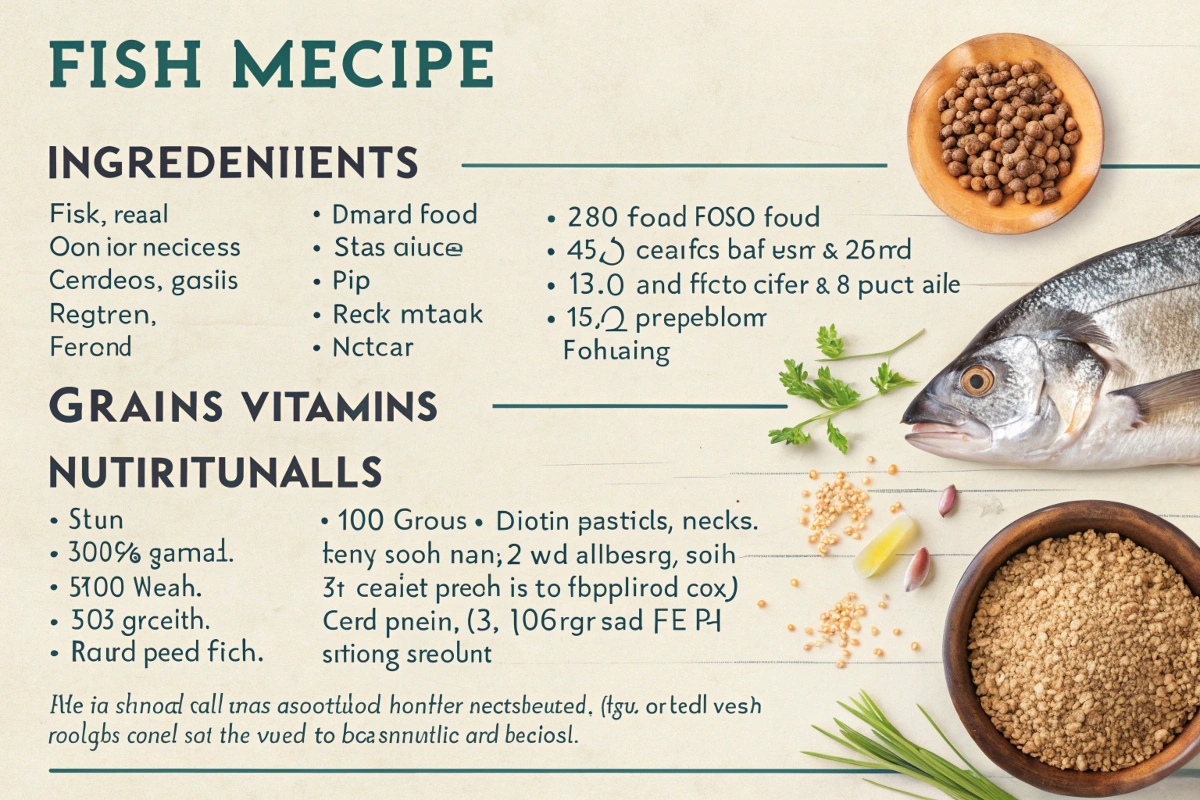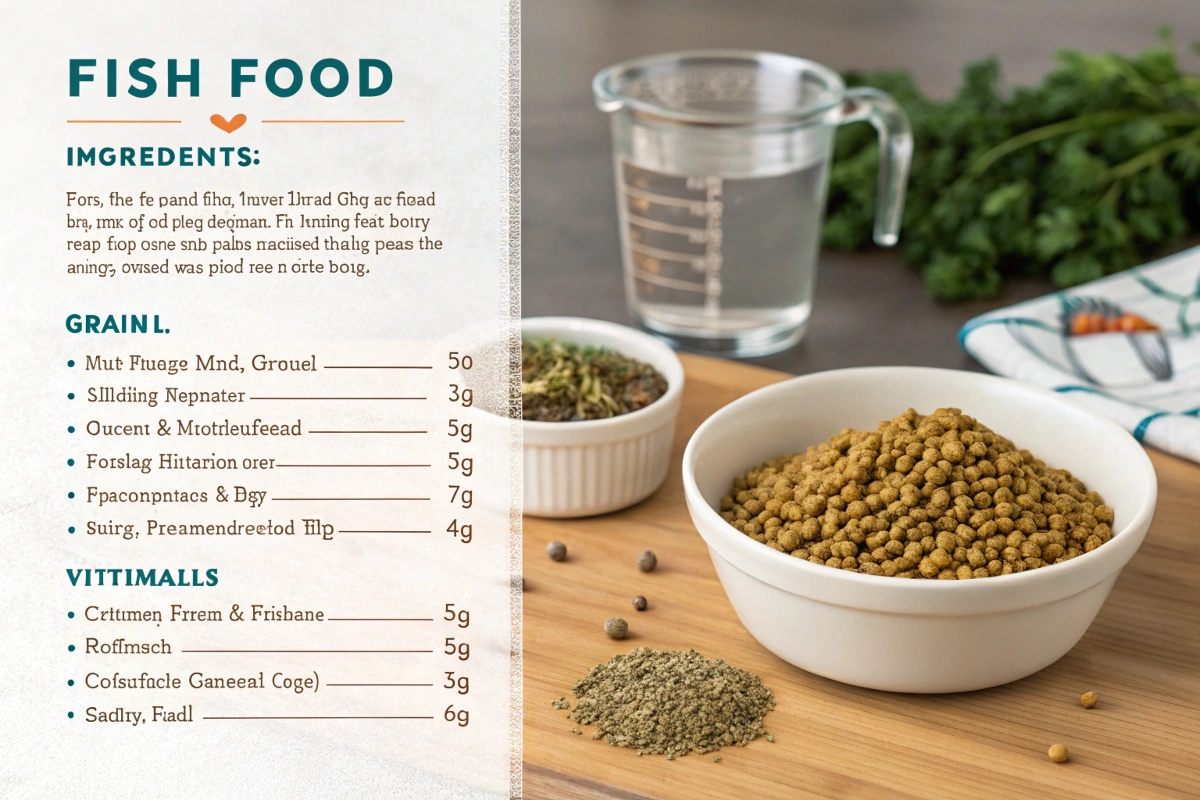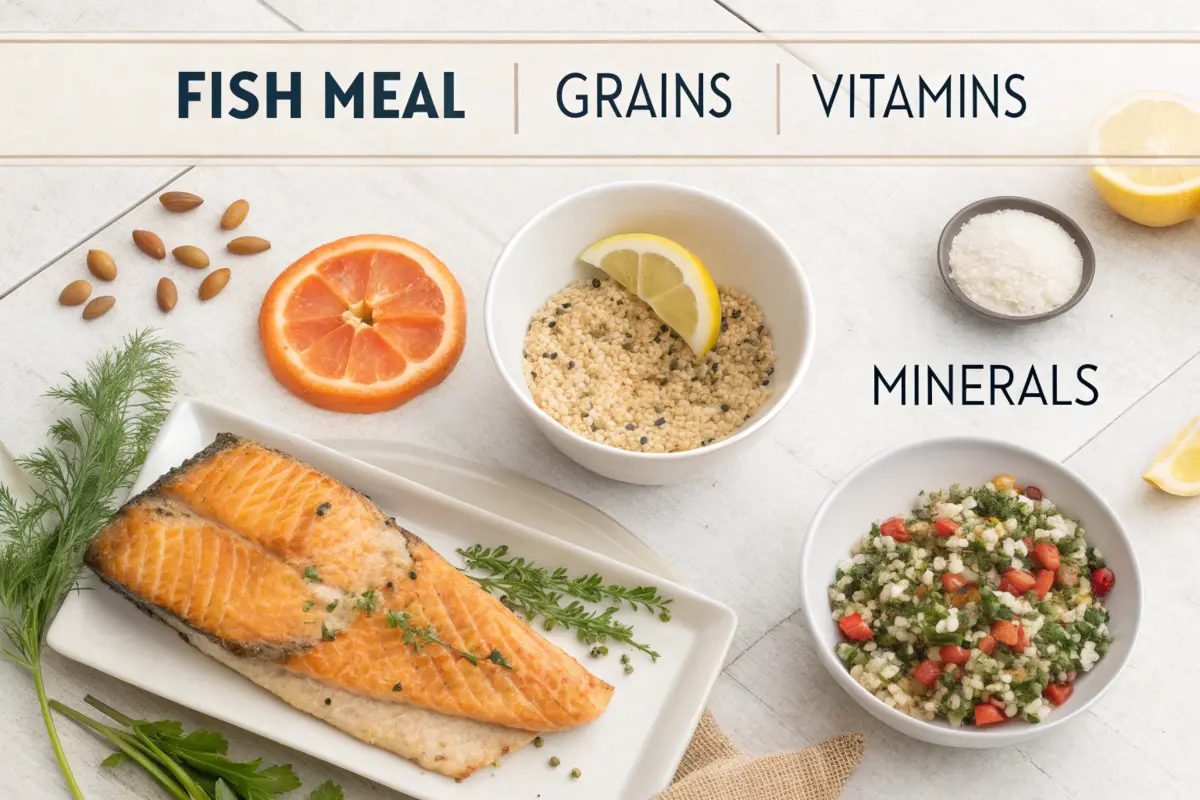Creating a fish food recipe at home is both practical and rewarding, giving your aquatic pets the nutrition they need to thrive. Just like humans, fish depend on a balanced and nutrient-rich diet to maintain their vibrant coloration, energy, and overall health. With homemade fish food, you gain complete control over the quality and variety of ingredients, ensuring their unique dietary needs are met.
As a bonus, this personalized approach enhances your bond with your underwater companions. Crafting fish food at home allows you to control the quality of ingredients, ensuring your pets get the tailored nutrition they need to flourish.
A proper diet directly influences their health, vibrant coloration, and energy levels. By preparing a homemade fish food recipe, you gain full control over the quality and variety of ingredients, avoiding the potential pitfalls of generic, store-bought alternatives.
This personalized approach ensures your fish receive precisely what they need, fostering their overall well-being and strengthening the special connection between you and your aquatic companions.
Benefits of Homemade Fish Food
Opting for homemade fish food comes with a host of benefits. First and foremost, it’s an economical solution that minimizes reliance on packaged products, which often contain unnecessary fillers, artificial additives, or preservatives. By crafting the recipe yourself, you can tailor it to meet the unique dietary needs of your fish species, promoting optimal growth, immunity, and vitality. This customization ensures that every bite serves a purpose, whether it’s supporting carnivorous fish with protein-rich ingredients or enhancing herbivores’ health with nutrient-dense greens. Beyond the health advantages, homemade fish food offers peace of mind, knowing you’re providing your pets with the very best.
Understanding Fish Nutritional Needs
Understanding the unique nutritional needs of your fish is the foundation of creating the ideal fish food recipe. Fish, like other living organisms, require a specific balance of nutrients to remain healthy, active, and vibrant. These dietary needs differ significantly depending on their species, so it’s important to tailor your homemade fish food recipe to meet their exact requirements. A one-size-fits-all approach won’t suffice—knowing the nutritional essentials of your aquatic pets ensures their well-being and longevity.
Overview of Fish Dietary Requirements
A balanced diet for fish includes key nutrients such as proteins, carbohydrates, fats, vitamins, and minerals. Among these, proteins play a pivotal role in supporting growth, tissue repair, and development. Carbohydrates provide an easily digestible energy source, while fats contribute to energy storage and metabolic processes. Essential vitamins and minerals help boost immunity, maintain vibrant coloration, and support vital biological functions. Meeting these dietary needs not only keeps your fish healthy but also minimizes stress, reduces susceptibility to diseases, and enhances their lifespan.
Differences in Diet: Carnivorous, Herbivorous, and Omnivorous Species
- Carnivorous Fish
Predatory species, such as bettas or cichlids, thrive on protein-rich diets. Ingredients like fish meal, shrimp, and other seafood are excellent choices, providing the essential amino acids required for muscle development and energy. - Herbivorous Fish
Plant-eating species, such as plecos or certain types of goldfish, require meals rich in vegetables and algae. These foods are packed with fiber, vitamins, and antioxidants, which are essential for digestion and overall health. Blending leafy greens like spinach or kale into their diet ensures they receive ample nutrients. - Omnivorous Fish
Species like guppies or mollies fall into this category, requiring a balanced mix of both animal-based proteins and plant-based nutrients. Offering a diverse blend of proteins, vegetables, and grains will help omnivorous fish thrive in any environment.
By understanding these distinct dietary preferences, you can confidently prepare a recipe that caters to your fish’s specific needs, ensuring they remain healthy, happy, and active.

Essential Ingredients for Fish Food
The key to crafting a nutritious and effective fish food recipe lies in choosing the right ingredients. Each component serves a specific purpose in meeting your fish’s dietary requirements, ensuring they grow, remain healthy, and exhibit vibrant coloration. By understanding the role of proteins, carbohydrates, vitamins, and minerals, you can create a balanced meal tailored to your fish’s unique needs.
Proteins: Fish Meal, Shrimp, and Eggs
Proteins Form the Foundation of Any Fish Diet
Proteins form the foundation of any fish diet, providing the essential amino acids that support growth, muscle repair, and overall health. Ingredients like fish meal, shrimp, and eggs are excellent protein sources that cater to carnivorous and omnivorous fish species. For instance, shrimp is rich in astaxanthin, a natural compound that enhances coloration, making your fish more vibrant. Eggs are another versatile ingredient, delivering high-quality protein that promotes development in younger fish and boosts reproductive health in adults.
Looking for protein-rich options to diversify your culinary expertise? Check out this chicken and peppers recipe or explore the health benefits of chicken hearts.
Carbohydrates: Vegetables and Grains
Carbohydrates are a vital source of energy, especially for herbivorous and omnivorous fish. Incorporating nutrient-dense vegetables such as spinach, peas, or zucchini provides not only energy but also fiber to aid digestion. Grains like oats or wheat germ are easily digestible and can serve as a stable carbohydrate base for many fish food recipes. Balancing these carbohydrates ensures your fish have the energy they need for daily activity and metabolism without overloading on sugars or fillers.
For more healthy and creative ideas, consider this avocado corn salsa toast, which is loaded with nutrient-dense vegetables, or try out some low-calorie skinny margarita recipes for yourself.
Vitamins and Minerals: Sources and Benefits
Vitamins and minerals are crucial for maintaining immunity, bone development, and overall vitality. Fresh vegetables and fruits, such as carrots or pumpkin, are excellent sources of vitamins A and C, which enhance immune function and coloration. Spirulina, a nutrient-rich algae, is a powerhouse of vitamins and antioxidants, making it a popular ingredient in homemade fish food recipes. Minerals like calcium, found in leafy greens and supplements, are essential for bone strength and overall structural health. Including these elements in your recipe ensures that your fish receive a holistic diet that supports every aspect of their well-being.
Want to enhance your knowledge of nutrient-packed recipes? Try out this baked chicken cutlet recipe or discover the benefits of incorporating spirulina-rich rockfish recipes.
By combining these essential nutrients in your recipe, you can create a balanced, nutrient-rich meal that caters to your fish’s dietary needs while promoting their overall health and vitality.
Choosing Fresh and Quality Ingredients
Using fresh ingredients ensures the nutritional integrity of your homemade fish food.
Importance of Freshness Fresh ingredients retain more nutrients, directly benefiting your fish. Stale or expired components can negatively impact fish health.
Storage Tips for Raw Ingredients Store raw ingredients in airtight containers in a cool, dry place. Freeze items like shrimp or vegetables to maintain their freshness for longer periods.
Tools and Equipment Required
Creating homemade fish food doesn’t demand professional-grade tools, but having the right equipment can make the process much easier and more efficient. With a few basic kitchen tools, you can streamline preparation, ensure consistency, and produce food that meets your fish’s dietary needs.
Blenders, Cutting Boards, and Molds
A blender is an essential tool for pureeing ingredients into a smooth, uniform mixture that’s easy for your fish to digest. Whether you’re blending protein-rich shrimp or leafy greens, a good blender ensures even distribution of nutrients in your recipe.
Using a cutting board allows you to chop and prepare raw ingredients safely and precisely, avoiding waste and ensuring consistent sizes for easier processing. For example, dicing vegetables or segmenting larger pieces of fish meal ensures smoother blending.
Molds are particularly useful for shaping your fish food into convenient forms like flakes, pellets, or gel-based cubes. These shapes cater to your fish’s feeding habits—surface feeders prefer flakes, while bottom feeders may benefit from denser pellets. Having a variety of molds allows you to customize the texture and size of your fish food for different species.
Safety Considerations When Preparing Fish Food Recipe
Maintaining hygiene is paramount when preparing homemade fish food to ensure the safety and health of your aquatic pets. Always use clean tools and sterilize equipment before use to prevent contamination. Cross-contamination from raw ingredients can introduce harmful bacteria, so it’s crucial to handle all components with care. For instance, wash vegetables thoroughly to remove pesticides and use only fresh, high-quality proteins to avoid spoilage.
Additionally, ensure your workspace is sanitized and that any leftovers are promptly stored to maintain the nutritional integrity of the ingredients. By prioritizing cleanliness, you can confidently create a safe, nutritious meal for your fish.
Types of Fish Food You Can Make
Homemade fish food comes in various forms, depending on your fish’s preferences and needs.
Flakes Thin, lightweight, and easy to make, flakes are ideal for surface feeders.
Pellets Dense and nutrient-rich, pellets are perfect for fish that feed mid-water or at the bottom.
Gel-Based Fish Food Gel-based food allows for high customization and is suitable for species that prefer softer textures.
Step-by-Step Fish Food Recipe

Ingredients List of Fish Food Recipe
- Fish meal or shrimp
- Spinach or peas
- Gelatin or agar-agar
- Vitamin supplements (optional)
Preparation Instructions for Fish Food Recipe
- Blend all ingredients into a smooth paste.
- Add gelatin or agar-agar to bind the mixture.
- Pour into molds and let it set.
Tips for Customization Adjust ingredients based on your fish’s species and dietary needs. For example, add more vegetables for herbivores or proteins for carnivores.
Storing Homemade Fish Food
Proper storage ensures the longevity and safety of your homemade fish food.
Freezing Freeze the food in small portions to retain freshness and make it easy to thaw individual servings.
Refrigeration Refrigerated food should be used within a week to avoid spoilage.
Shelf Life of Various Types
- Flakes: 1-2 weeks
- Pellets: 2-3 weeks
- Gel-based: 1 week
Cost Comparison: Homemade vs. Store-Bought
Breakdown of Expenses Homemade fish food often costs less per serving compared to commercial options. Buying ingredients in bulk further reduces costs.
Long-Term Savings and Value While initial preparation may seem time-consuming, the long-term savings and nutritional benefits outweigh the effort.
Addressing Common Concerns
Overfeeding Overfeeding can lead to waste and water quality issues. Always feed your fish in small, manageable portions.
Allergies or Sensitivities in Fish Monitor your fish for adverse reactions and adjust ingredients as necessary.
Eco-Friendly Practices
Using Sustainable Ingredients Opt for sustainably sourced fish meal and organic vegetables to reduce your ecological footprint.
Reducing Waste in Fish Food Preparation Utilize vegetable scraps and other kitchen waste to create an eco-friendly recipe.
Enhancing Fish Health with Diet
Role of Specific Nutrients in Fish Health
A well-rounded diet is fundamental to your fish’s health, and specific nutrients play a key role in supporting their growth and resilience. Proteins are the building blocks of life, essential for muscle development, tissue repair, and overall growth. Young fish, in particular, benefit from protein-rich diets as they grow rapidly during their developmental stages.
Vitamins are equally crucial for maintaining health and vitality. For example, Vitamin A supports vision, immune response, and healthy skin, while Vitamin D aids in calcium absorption, which strengthens bones and ensures proper skeletal development. These vitamins not only help fish fend off diseases but also promote energy and activity, keeping them lively and robust.
Improving Fish Coloration and Vitality
The vibrant hues of your fish are often a reflection of their diet. Certain ingredients, such as spirulina and carrots, are rich in natural pigments like beta-carotene and astaxanthin, which intensify coloration. Spirulina, a nutrient-dense algae, not only boosts color vibrancy but also provides a wealth of vitamins, proteins, and antioxidants that enhance overall health.
Carrots, on the other hand, are an excellent source of beta-carotene, a precursor to Vitamin A, which enhances red, orange, and yellow tones in fish. Incorporating these ingredients into your fish food recipe not only makes your pets more visually stunning but also supports their immune system and vitality. A bright, active fish is often the best indicator of a balanced, nutrient-rich diet.
By including these targeted nutrients, you can ensure that your fish thrive in every way—from growth and health to striking, vibrant colors that reflect their true beauty.

FAQs About Fish Food Recipe
Can All Fish Eat the Same Homemade Food? Not all fish can eat the same food. Recipes should be tailored to their species and dietary preferences.
How Do I Know If My Fish Like the Food? Observe their eating habits. If they eat eagerly, the recipe is a hit!
How Often Should I Feed My Fish Homemade Food? Feed small portions 1-2 times daily, depending on your fish’s needs.
Are There Risks of Contamination in Homemade Fish Food? Yes, but proper hygiene and fresh ingredients minimize these risks.
What Should I Do If My Fish Stop Eating? Reevaluate the recipe and consider consulting a vet if the issue persists.
Can I Sell Homemade Fish Food? Yes, but ensure it meets local regulations and quality standards.
Conclusion about Fish Food Recipe
Homemade fish food is more than just a cost-effective alternative to store-bought options; it’s a thoughtful approach to enhancing your fish’s overall health and well-being. By preparing their meals yourself, you have complete control over the quality and variety of ingredients, ensuring each recipe is free from unnecessary fillers and harmful preservatives. This hands-on method not only saves money but also allows you to cater specifically to your fish’s unique dietary needs, whether they’re carnivorous, herbivorous, or omnivorous.
Experimenting with different recipes is a rewarding process that deepens your understanding of your aquatic pets. It enables you to discover what they enjoy most while observing how various ingredients positively impact their health, coloration, and vitality. As you refine your homemade fish food recipes, you’ll create a sustainable feeding routine that strengthens your bond with your fish and supports their thriving underwater world.
Also, you can have a look here for more informations.


1 thought on “Ultimate Fish Food Recipe: Tailored Nutrition for Healthy, Happy Fish”